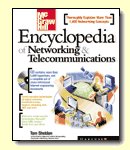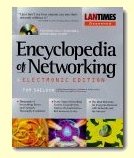|
Site home page
(news and notices)
Get alerts when Linktionary
is updated
Book updates and addendums

Get info about the Encyclopedia of Networking
and Telecommunicatons, 3rd edition (2001)

Download the electronic version of the Encyclopedia
of Networking, 2nd edition (1996). It's free!
Contribute to this site
Electronic licensing info
|
|
Data Link Protocols
Related Entries Web Links New/Updated Information
Note: Many topics at this site are reduced versions of the text in "The Encyclopedia of Networking and Telecommunications." Search results will not be as extensive as a search of the book's CD-ROM.
Often called layer 2 protocols, data link protocols exist in the protocol layer just above the physical layer relative to the OSI protocol model. Data link protocols provide communication between two devices. Because there are many different ways to connect devices, there are many different data link protocols. The defining factors are
- Dedicated point-to-point links between two devices, such as modem, bridges, or routers
- Shared media links in which multiple devices share the same cable (i.e., Ethernet LAN)
The PPP (Point-to-Point Protocol) that people use to connect to the Internet via a dial-up modem is an example of a data link protocol. Because the link between two systems is point to point, the bits are always delivered from sender to receiver in order. Also, unlike shared-media LANs in which multiple stations attempt to use the network, there is no contention.
Data link protocols may provide any of the following services:
- Framing
Data is broken up into frames that are transmitted as independent units. If errors are detected in a frame, it is only necessary to retransmit that frame.
- Session setup and termination
For reliable services, session control messages are used by end systems to exchange status information about the session.
- Error detection
Determines whether a frame has been delivered accurately. A checksum is calculated on a frame by the sender, and the receiver must perform the same calculation and come up with the same checksum. If not, the frame is considered corrupted. If reliable services are being used, the frame is retransmitted. For nonreliable services, the frame is dropped and upper-layer protocols are relied on to handle the problem.
- Addressing on a multipoint medium such as a LAN
A computer's address is usually the hardwired address of the NIC (network interface card).
- Flow control
A technique that prevents the sender from sending more, overflowing the receiver with more data than it can handle.
Reliable services were essential in the days of dumb terminals that did not have the capabilities to perform error or frame checking. Today, end systems have their own processing power, so reliability services are not essential in the network itself. Instead, reliable services are executed on end systems. TCP is a reliable transport layer protocols that can replace network- level reliability services.
Common Data Link Protocols
The most common data link level protocols are listed here with a short description. Note that most of these data link protocol are used for WAN and Modem Connections. LLC is a LAN data link protocol.
- SDLC (Synchronous Data Link Protocol)
This protocol was originally developed by IBM as part of IBM's SNA (Systems Network Architecture). It was used to connect remote devices to mainframe computers at central locations in either point-to-point (one-to-one) or point-to-multipoint (one-to-many) connections.
- HDLC (High-level Data Link Control) This protocol is based on SDLC and provides both a best-effort unreliable service and a reliable service. It is used with various serial interface protocols defined in the physical layer, such as EIA/TIA-232, V.24, V.35, and others.
- SLIP (Serial Line Interface Protocol)
SLIP is a data link control facility for transmitting IP packets, usually between an ISP (Internet service provider) and a home user over a dial-up link. SLIP has some limitations, including a lack of any error-detection and correction mechanisms. It is up to higher-layer protocols to perform these checks. Used over much of the same serial interfaces as HDLC.
- PPP (Point-to-Point Protocol) PPP provides the same functionality as SLIP (i.e., it is commonly used for Internet connections over dial-up lines); but it is a more robust protocol that can transport not only IP, but also other types of packets. Frames contain a field that identifies the type of protocol being carried (IP, IPX, and so on). It is used over much of the same serial interfaces as HDLC.
- LAP (Link Access Procedure) LAP has reliability service features and comes in three varieties. LAPB (LAP Balanced) is a protocol that provides point-to-point connections on X.25 packet-switched networks. LAPD (LAP D-Channel) provides the data link control over the D channel of an ISDN (Integrated Services Digital Network) connection. LAPF (LAP Frame-Mode Bearer Services) provides the data link for frame relay networks.
- Frame Relay LAP used with X.25 is highly reliable, but it also has high overhead. Frame relay does away with the reliability services (i.e., error-correction mechanisms are removed) to improve throughput.
- LLC (Logical Link Control) The IEEE (Institute of Electrical and Electronic Engineers) defines this protocol in its 802.x family of networks standards. The ANSI FDDI standard also uses this protocol. LLC is discussed further in the next section.
LAN Data Link Controls
The IEEE (Institute of Electrical and Electronics Engineers) has defined a number of LAN technologies in the data link layer, including Ethernet, Fast Ethernet, Gigabit Ethernet, and token ring. You can refer to the related entries page for more information.
The actual data link layer is split into two sublayers, called the MAC (Medium Access Control) sublayer and the LLC (Logical Link Control) sublayer, as shown in Figure D-11. The lower MAC layer defines the media access method, which can be CSMA/CD (carrier sense multiple access/collision detection), token ring, or other IEEE physical interface. The LLC sublayer provides a way for the network layer to communicate with one of these protocols.
Figure 11: See book
Data link layer devices include bridges and switches. Refer to "Bridges and Bridging" and "Switching and Switched Networks" for more information.
Frame relay is a high-speed data link protocol. It uses LAPF (Link Access Procedure for Frame-Mode Bearer Services). See "Frame Relay" for more information. ATM (Asynchronous Transfer Mode) is a cell-based data link-level service. See "ATM (Asynchronous Transfer Mode)" for more information.
Copyright (c) 2001 Tom Sheldon and Big Sur Multimedia.
All rights reserved under Pan American and International copyright conventions.

|

